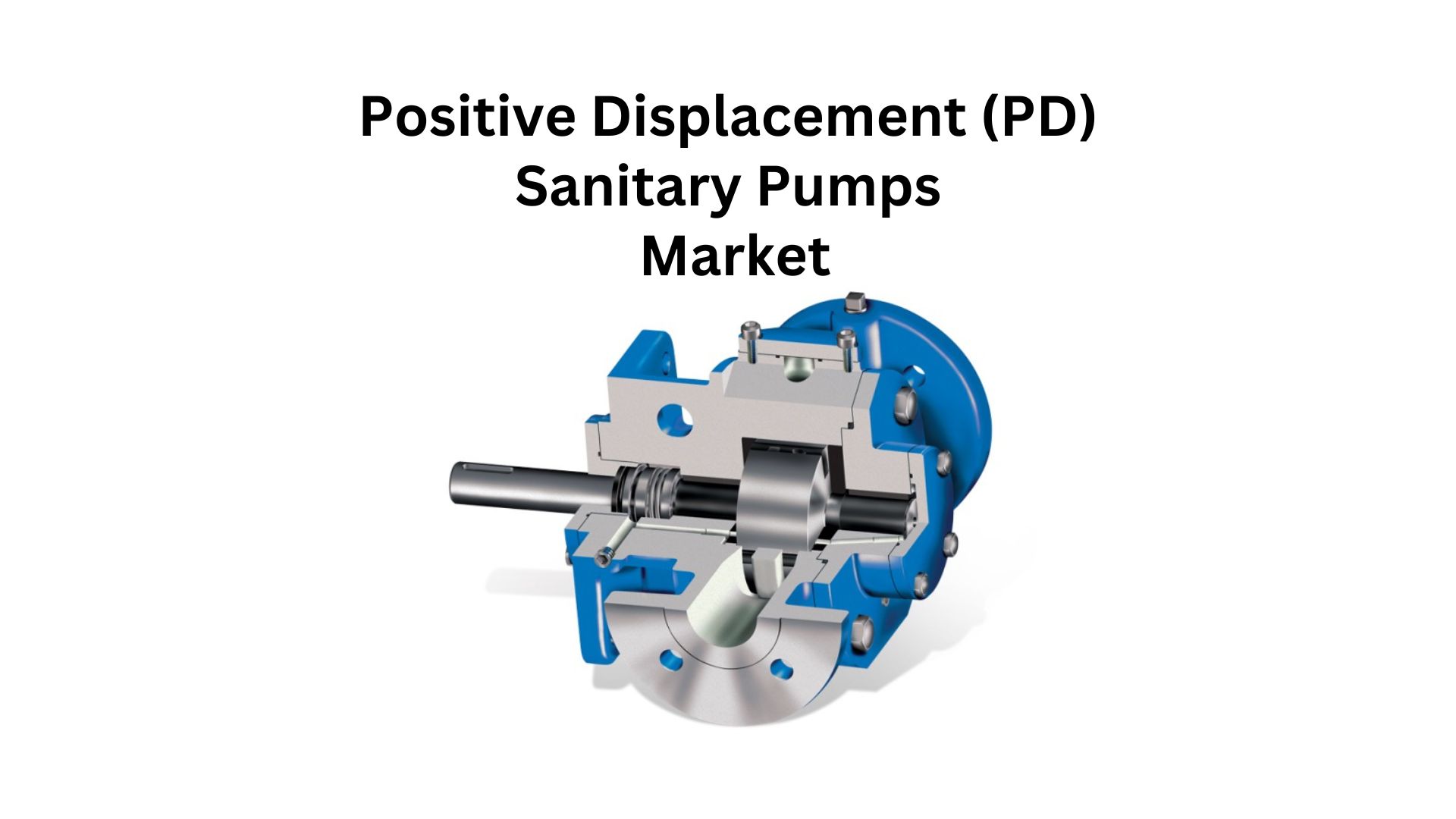Growth of the Positive Displacement (PD) Sanitary Pumps Market Driven by Improvements in Product Design | CAGR of 9.99%

Page Contents
Market Overview
Published Via 11Press: Positive displacement (PD) sanitary pumps are widely used in food, beverage and pharmaceutical industries for transporting viscous, shear-sensitive or particulate-laden fluids. Positive displacement (PD) sanitary pumps Market work by trapping a specific amount of liquid inside an internal chamber or cavity and then forcing it out through their discharge port through mechanical action.
The Positive Displacement (PD) Sanitary Pumps Market size is expected to reach USD 25.27 Bn by 2033, up from its current value of USD 8.87 Bn in 2022, growing at an annual compound growth rate (CAGR) of 9.99% from 2023-2033.
There are various types of positive displacement (PD) pumps, such as rotary lobe pumps, progressive cavity pumps, peristaltic pumps and piston pumps. Each has its own design and operating principles but all share certain common features such as self-priming capability that allows them to draw fluid into the pump without additional priming required, constant flow rate regardless of changes in viscosity or pressure, versatility with various viscosities from low viscous liquids up to highly viscous materials, designed with integrity in mind while minimising shear or turbulence during transfer process.
Pumps for pharmaceutical dispensing (PD) are usually constructed of materials compatible with the fluids they will handle and designed for easy disassembly and cleaning. Many feature flushable seals or quick-connect fittings to facilitate cleaning and upkeep.
Key Takeaways
- PD pumps are frequently employed in the food, beverage and pharmaceutical industries for transporting viscous, shear-sensitive or particulate-laden fluids.
- PD pumps work by trapping a certain amount of fluid inside an internal chamber or cavity and then forcing it out through its discharge port through mechanical action.
- Physical Destruction pumps (PD pumps) come in various varieties, such as rotary lobe pumps, progressive cavity pumps, peristaltic pumps and piston pumps.
- PD pumps are self-priming, provide a constant flow rate and can handle various fluid viscosities.
- PD pumps are engineered to protect the integrity of the fluid being transferred, minimizing shear and turbulence.
- PD pumps are typically constructed of materials compatible with the fluids they will handle and designed for easy disassembly and cleaning.
- PD pumps boast features like flushable seals and quick-connect fittings to simplify cleaning and maintenance tasks.
- PD pumps are an integral component of many sanitary processing operations, providing reliable and efficient fluid transfer while safeguarding product quality and safety.

Click Here To Access Sample Pages Of This Report: https://marketresearch.biz/report/positive-displacement-pd-sanitary-pumps-market/request-sample/
Regional Snapshot
- North America: The North American market for PD sanitary pumps is forecast to experience steady growth due to rising food and beverage demand. The United States leads the North American PD sanitary pump market, with significant demand from dairy, beverage and pharmaceutical industries.
- Europe: The European market for PD sanitary pumps is expected to expand steadily due to an increasing demand for processed food products and stringent regulations regarding food safety. Countries such as Germany, France, and the UK are the primary markets in this regard in Europe.
- Asia-Pacific: The Asia-Pacific region is projected to experience the highest growth rate in PD sanitary pumps market due to rising food and beverage demand from countries like China, India, and Japan. Furthermore, the pharmaceutical industry in this region will contribute significantly to market expansion.
- Latin America: The Latin American market for PD sanitary pumps is expected to experience moderate growth due to an increasing demand for processed food products and beverages. Brazil and Mexico are the two leading markets in this region for PD sanitary pumps.
- Middle East and Africa: The Middle East and Africa market for PD sanitary pumps is expected to experience steady growth due to the increasing demand for processed food products and the expanding pharmaceutical industry. The United Arab Emirates and South Africa are the two largest markets in this region for PD sanitary pumps.
Enquire Here & Query for report: https://marketresearch.biz/report/positive-displacement-pd-sanitary-pumps-market/#inquiry
Drivers
- Increasing Demand for Processed Food and Beverages: The growing demand for processed food products and beverages is propelling the growth of the PD sanitary pumps market. These pumps are essential in production and processing food and beverage items as they can handle a range of fluid viscosities while maintaining the integrity of the fluids being transferred.
- Stringent Regulations on Food Safety: Strict regulations regarding food safety are fuelling the growth of the PD sanitary pumps market. These pumps ensure cleanliness and hygiene in processing environments, decreasing the risk of contamination.
- The Growing Pharmaceutical Industry: The growing pharmaceutical industry is propelling the demand for PD sanitary pumps. These pumps are essential in production and processing pharmaceutical products where maintaining product purity and quality is essential.
- The Growing Demand for Personal Care and Cosmetics: The rising popularity of personal care and cosmetic products is propelling the growth of the PD sanitary pumps market. These pumps are employed in production and processing operations where product purity and quality must be ensured.
- Technological Advancements: Technological advancements in PD sanitary pump design and operation are fueling growth in this market. Manufacturers are creating new, innovative designs that offer improved efficiency, dependability, and ease of maintenance.
Restraints
- The high capital investment required for installation of PD sanitary pumps is a major obstacle for this market, making it difficult for small and medium-sized enterprises to invest in these pumps, potentially restricting growth. Furthermore, regular maintenance and cleaning are necessary in order to guarantee optimal performance and prevent contamination – leading to high maintenance costs which could deter some buyers. Low cost alternatives such as centrifugal pumps and air-operated diaphragm pumps could potentially act as another deterrent since they cost effectively perform some if not all functions of PD sanitary pumps.
- Some buyers may find PD sanitary pumps more energy-intensive than other types of pumps, which could raise operating costs and deter some buyers. Furthermore, these pumps may not be ideal for all applications; they are specifically designed for transporting viscous, shear-sensitive or particulate-laden fluids which puts them at a disadvantage in certain industries.
Opportunities
- Emerging markets provide significant potential for the PD sanitary pumps market. These economies are experiencing rapid industrialization and urbanization, leading to an increase in demand for food & beverages, pharmaceuticals, as well as personal care products. As these industries expand, the demand for PD sanitary pumps is expected to rise.
- Industry 4.0 technologies such as the Internet of Things (IoT) artificial intelligence (AI) and big data analytics are anticipated to fuel this growth in PD sanitary pumps sales. These technologies can be employed to optimize the performance of PD sanitary pumps, reduce maintenance expenses and enhance product quality. The growing focus on energy efficiency presents an opportunity for the PD sanitary pump market; manufacturers are creating new and innovative designs with better energy efficiency ratings which could help customers reduce their operating expenses.
- The growing demand for high-pressure pumps presents an opportunity for the PD sanitary pumps market. High-pressure PD sanitary pumps are used across various industries, such as oil and gas, food and beverage and pharmaceuticals. With the shift towards sustainable manufacturing practices comes another chance in this space. manufacturers are developing more eco-friendly pumps with reduced energy consumption and improved material efficiency.
Challenges
- The PD sanitary pumps market is highly competitive, with several established players competing for market share. This can make it challenging for new entrants or smaller players to successfully compete. Furthermore, PD sanitary pumps require specialized knowledge to design, operate and maintain properly; customers without sufficient resources or expertise may find it difficult to effectively operate or maintain these machines.
- The PD sanitary pumps market is subject to stringent regulations regarding food safety, product purity and hygiene. Non-compliance can have costly repercussions for both manufacturers and customers alike; thus limiting their appeal in emerging markets or small businesses. Despite their advantages, adoption may still be limited in certain industries due to other types of pumps such as centrifugal or air-operated diaphragm pumps being preferred over PD sanitary ones.
Market Segmentation
Global PD Sanitary Pumps Market, by Rotary PD Sanitary Pumps Type
- Rotary Lobe
- Twin Screw
- Progressive Cavity
- Eccentric Disc
- Gear
- Sinusoidal
- Hose
Global PD Sanitary Pumps Market, by Reciprocating PD Sanitary Pumps Type
- Piston/Plunger
- Diaphragm
Global PD Sanitary Pumps Market, by End-use
- Food & Beverage
- Pharmaceutical
- Cosmetics
- Biotechnology
- Water Treatment Systems
- Textile
- Others (Bio Fuel & Semiconductors)
Key Players
- SPX Corporation
- Fristam Pumps
- IDEX Corporation
- Alfa Laval AB
- PSG Dover
- Xylem Inc. and ITT Corporation
Report Scope
| Report Attribute | Details |
| Market size value in 2022 | USD 8.87 Bn |
| Revenue forecast by 2033 | USD 25.27 Bn |
| Growth Rate | CAGR Of 9.99% |
| Regions Covered | North America, Europe, Asia Pacific, Latin America, and Middle East & Africa, and Rest of the World |
| Historical Years | 2017-2022 |
| Base Year | 2022 |
| Estimated Year | 2023 |
| Short-Term Projection Year | 2028 |
| Long-Term Projected Year | 2033 |
Growing Demand => Request for Customization
Recent Developments
- Development of Smart PD Sanitary Pumps: Manufacturers are creating advanced PD sanitary pumps that feature sensors and software to monitor pump performance and optimize operation. These pumps can provide real-time data on pressure, flow rate, temperature – enabling them to detect issues before they escalate into major issues.
- Increased Focus on Energy Efficiency: There is an increasing emphasis on energy efficiency within the PD sanitary pump market. Manufacturers are striving to develop pumps that use less power with features such as variable speed drives and improved motor efficiency.
- Advancements in Materials: Manufacturers are creating new materials for PD sanitary pumps to offer improved durability, chemical resistance and hygiene. For instance, some firms use materials like stainless steel, ceramic and titanium for improved corrosion resistance.
- Adoption of Industry 4.0 Technologies: The adoption of Industry 4.0 technologies such as the Internet of Things (IoT) and big data analytics is driving innovation in the PD sanitary pumps market. These tools can be utilized to optimize pump performance, enhance maintenance procedures, and reduce downtime.
- Increased Focus on Sustainability: There is an increasing emphasis on sustainability in the PD sanitary pumps market, with manufacturers developing pumps that use less energy and materials while being more eco-friendly. Furthermore, some firms are creating pumps which can be disassembled and recycled at their end of life.
Key Questions
1. What Are Positive Displacement (PD) Sanitary Pumps?
Positive displacement pumps use a positive displacement mechanism to move fluids through an system. They're ideal for sanitary applications where hygiene, product purity and cleanability must be guaranteed.
2. What are the main advantages of PD Sanitary Pumps?
PD Sanitary Pumps provide several advantages, such as high levels of hygiene and product purity, gentle handling of fluids, and ability to manage viscosity or shear-sensitive substances. Moreover, they require little cleaning or upkeep, plus provide precise flow control with pinpoint accuracy.
3. What are some of the applications of PD Sanitary Pumps?
PD Sanitary Pumps find use in many areas, such as food and beverage processing, pharmaceuticals, cosmetics and personal care items. Furthermore, they produce chemicals, adhesives and paints.
4. What are the different types of PD Sanitary Pumps?
There are various PD Sanitary Pump types, such as rotary lobe pumps, piston pumps and progressive cavity pumps. Each has its own distinct design and operating characteristics that make them suitable for different applications.
5. What are some of the challenges confronting the PD Sanitary Pumps market?
The PD Sanitary Pumps market faces several difficulties, such as intense competition, technological complexity, stringent regulations, high cost and limited adoption. Addressing these obstacles will be essential to accelerate market growth and expansion.
Contact us
Contact Person: Mr. Lawrence John
Marketresearch.Biz (Powered By Prudour Pvt. Ltd.)
Tel: +1 (347) 796-4335
Send Email: [email protected]
The team behind market.us, marketresearch.biz, market.biz and more. Our purpose is to keep our customers ahead of the game with regard to the markets. They may fluctuate up or down, but we will help you to stay ahead of the curve in these market fluctuations. Our consistent growth and ability to deliver in-depth analyses and market insight has engaged genuine market players. They have faith in us to offer the data and information they require to make balanced and decisive marketing decisions.



